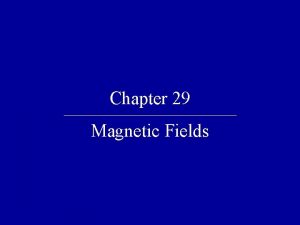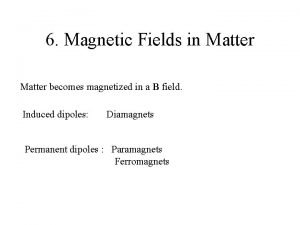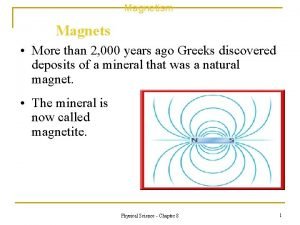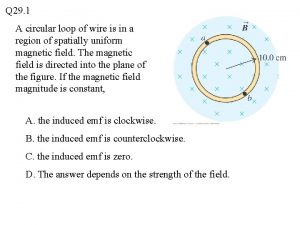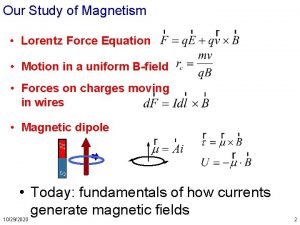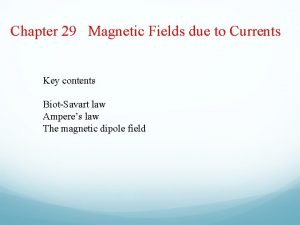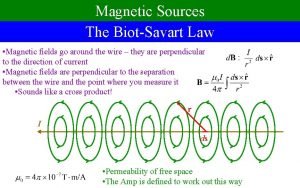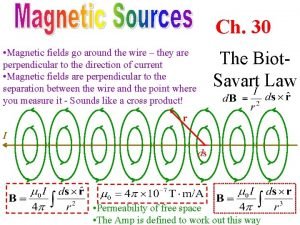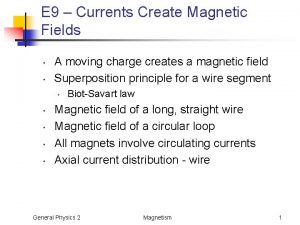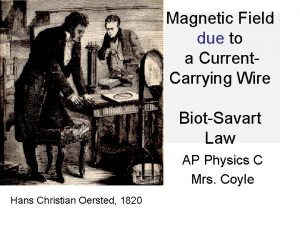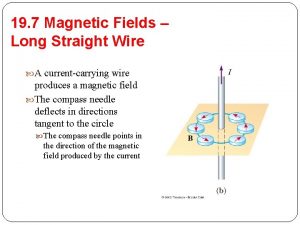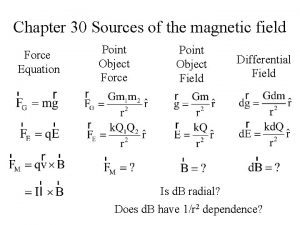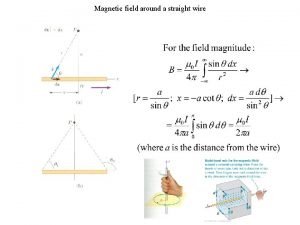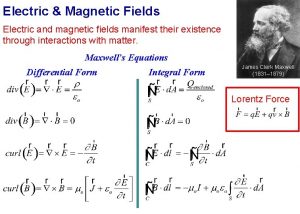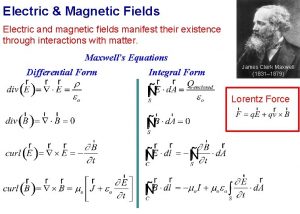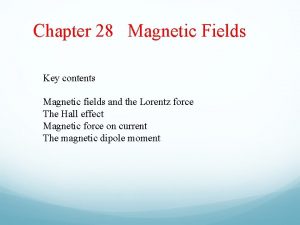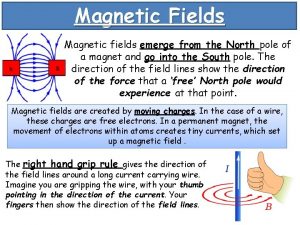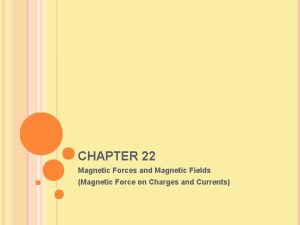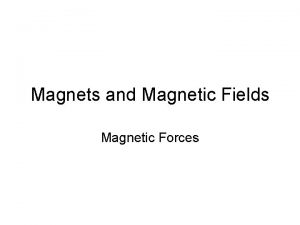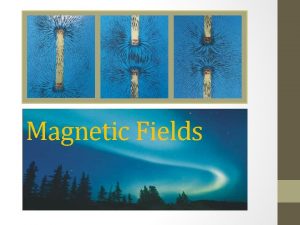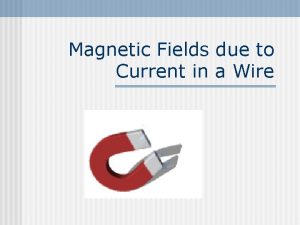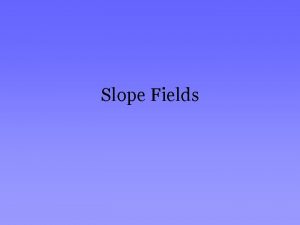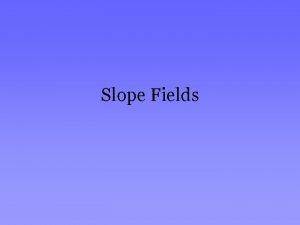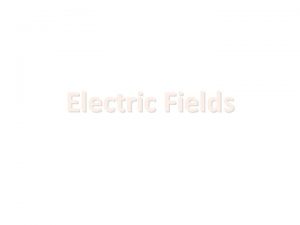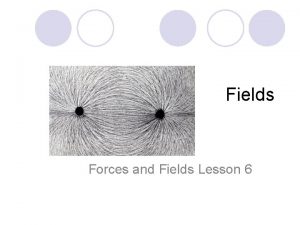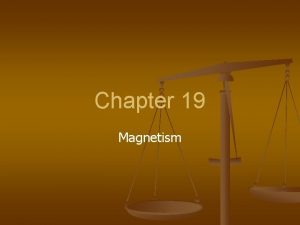Ch 30 Magnetic fields go around the wire



























- Slides: 27

Ch. 30 • Magnetic fields go around the wire – they are perpendicular to the direction of current • Magnetic fields are perpendicular to the separation between the wire and the point where you measure it - Sounds like a cross product! The Biot. Savart Law = r I ds • Permeability of free space • The Amp is defined to work out this way

Sample Problem A loop of wire consists of two quarter circles of radii R and 2 R, both centered at a point P, and connected with wires going radially from one to the other. If a current I flows in the loop, what is the magnetic field at the point P? • Do one side at a time • First do one of the straight segments • ds and r-hat are parallel • No contribution to the integral • Other straight segment is the same • Now do inner quarter loop (assume x-y) • Outer loop opposite direction, similar ds ds I ds P R ds 2 R

Magnetic Field from a Finite Wire • Magnetic field from a finite straight wire: • Let a be the distance the point is from the wire • Let x be the horizontal separation P -x 1 1 a r O x ds 2 I Skipped x Derivation 2 Warning: My differs from that of the book

Magnetic Field from a Wire • Magnitude is found from the formula • Direction is found from the right hand rule • Place thumb in direction of current flow • Fingers curl in direction of B-field • Infinite wire: 1 • Angles are simple Two wires have the same current I flowing through them. If we want the magnetic field between them to be large and up, we should have the current in the upper one flow _____ and the lower one ______ A) Left, Right B) Left, Left D) Right, Left E) Right, Right 2 I a

MCAT question Ans D

Ans E

Sample problem A regular hexagon whose center is a distance a = 1 cm from the nearest side has current I = 4. 00 A flowing around it. The current flows N = 500 times around. What is the total magnetic field at the center? I 60 a 60 60 • Draw in the two directions from the center to the corners of one segment • Top angle is one-sixth of a circle, or 60 degrees • Total angles in circle is 180, so other two angles are 60 each • Use formula to get magnetic field – right hand rule says up. • Multiply by all six side, and then by 500 cycles

I Right Hand Rule for Loops • If you curl your fingers in the direction the current flows, thumb points in direction of B-field inside the loop • Works for solenoids too (later) B Curl fingers around I and Thumb point to Mag dipole moment. Also gives B inside a loop

Warmup 14

Force Between Parallel Wires I 1 I 2 F d L • One wire – infinite – creates a magnetic field • Other wire – finite or infinite – feels the force • Attractive if current is parallel, repulsive if anti-parallel

Ans B

Ans D

Warmup 14

Ampere’s Law (original recipe) • Suppose we have a wire coming out of the plane • Let’s integrate the magnetic field around a closed path • There’s a new symbol for such an integral • Circle means “over a closed loop” • The magnetic field is parallel to direction of integration ds ds cos • What if we pick a different path? d r I • We have demonstrated this is true no matter what path you take • We don’t even need a straight infinite wire • All that matters is that current passes through the closed Ampere loop

Understanding Ampere’s Law • If multiple currents flow through, add up all that are inside the loop • Use right-hand rule to determine if they count as + or – • Curl fingers in direction of Ampere loop • If thumb points in direction of current, plus, otherwise minus • The wire can be bent, the loop can be any shape, even non-planar There are currents going in and out of the screen as sketched at right. What is the ingtegral of the magnetic field around the path sketched in purple? A) 0(11 A) B) 0(-11 A) C) 0(3 A) D) 0(-3 A) E) None of the above • Right hand rule causes thumb to point down • Downward currents count as +, upwards as – 1 A 2 A 4 A 5 A 7 A Note. If point thumb in direction of net current and sum in direction of curled fingers, sum will be positive – B points in that direction.

JIT Quick Quiz 30. 3 Ans c>a>d>b

JIT Quick Quiz 30. 4 Ans a=c=d>b

Using Ampere’s Law • Ampere’s Law can be used – rarely – to calculate magnetic fields • Need lots of symmetry – usually cylindrical A wire of radius a has total current I distributed uniformly across its cross-sectional area. Find the magnetic field everywhere. I I End-on view • Draw an Ampere loop outside the wire – it contains all the current • Magnetic field is parallel to the direction of this loop, and constant around it • Use Ampere’s Law • But we used a loop outside the wire, so we only have it for r>a

Using Ampere’s Law (2) • Now do it inside the wire • Ampere loop inside the wire does not contain all the current • The fraction is proportional to the area End-on view a

Warmup 15

Solenoids • Consider a planar loop of wire – any shape – with a current I going around it • Now, stack many, many such loops • Treat spacing as very closely spaced • Assume stack is tall compared to size of loop • Outside, most of the field cancels for ideal solenoid (long, thin, tightly packed)

Field Inside a Solenoid • It remains only to calculate the magnetic field inside • We use Ampere’s law • Recall, neglible B-field outside • There may be many (N) current loops within this Ampere loop • Let n = N/L be loops per unit length L • Works for any shape solenoid, not just cylindrical • For finite length solenoids, there are “end effects”

Magnetic Flux • Magnetic flux is defined exactly the same way for magnetism as it was for electricity A cylindrical solenoid of radius 10 cm has length 50 cm and has 1000 turns of wire going around it. What is the magnetic field inside it, and the magnetic flux through it, when a current of 2. 00 A is passing through the wire? A Tesla meter 2 is also called a Weber (Wb)

Gauss’s Law for Magnetism • Magnetic field lines always go in circles – there are no magnetic monopole sources • For closed surfaces, any flux in must go out somewhere else A regular tetrahedron (four sides, all congruent) has a cylindrical magnet placed in the middle of the bottom face. There is a total of 0. 012 T m 2 of magnetic flux entering the bottom face. What is the total flux from one of the three top faces? A) 0. 006 T m 2 B) 0. 004 T m 2 C) 0. 003 T m 2 D) 0. 012 T m 2 E) None of the above • Flux in bottom must equal total flux out other three sides • Other three sides must have equal flux, by symmetry Sign of entering flux is negative

Ans D

Solve on Board

Warmup 15 http: //www. youtube. com/watch? v=A 1 vy. B-O 5 i 6 E
 Red fields
Red fields Magnetic force quiz
Magnetic force quiz Learning: module 26: magnetic forces and fields
Learning: module 26: magnetic forces and fields Electric currents and magnetic fields
Electric currents and magnetic fields Scrap heap magnet circuit diagram
Scrap heap magnet circuit diagram Electric currents and magnetic fields
Electric currents and magnetic fields Magnetic field in matter
Magnetic field in matter A single wire wrap into a cylindrical wire coil is called
A single wire wrap into a cylindrical wire coil is called A circular loop of wire is in a region of spatially uniform
A circular loop of wire is in a region of spatially uniform Unit of electric field
Unit of electric field Magnetic field outside a wire
Magnetic field outside a wire Magnetic field of a finite wire
Magnetic field of a finite wire Magnetic field of a finite wire
Magnetic field of a finite wire Magnetic field equation wire
Magnetic field equation wire Site:slidetodoc.com
Site:slidetodoc.com Magnetic field for a long straight wire
Magnetic field for a long straight wire Magnetic field in wire formula
Magnetic field in wire formula Magnetic force particle
Magnetic force particle Types of ferrites
Types of ferrites Unit of flux
Unit of flux Magnetic moment and magnetic field relation
Magnetic moment and magnetic field relation كما تدين تدان english
كما تدين تدان english Goes around comes around meaning
Goes around comes around meaning Thế nào là mạng điện lắp đặt kiểu nổi
Thế nào là mạng điện lắp đặt kiểu nổi Hình ảnh bộ gõ cơ thể búng tay
Hình ảnh bộ gõ cơ thể búng tay Các loại đột biến cấu trúc nhiễm sắc thể
Các loại đột biến cấu trúc nhiễm sắc thể Thế nào là sự mỏi cơ
Thế nào là sự mỏi cơ Vẽ hình chiếu đứng bằng cạnh của vật thể
Vẽ hình chiếu đứng bằng cạnh của vật thể

